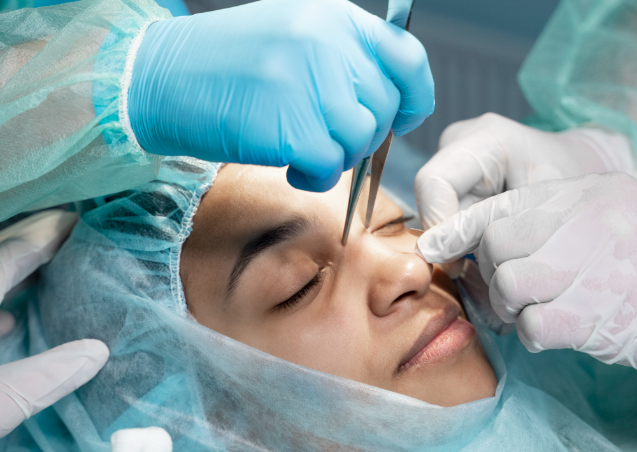
Rhinoplasty is one of the most common cosmetic procedures in the world, and is a surgical procedure that does wonders in restructuring the shape of your nose. Rhinoplasty surgery can be performed for cosmetic and functional reasons, such as correcting breathing problems or repairing damage from an injury.
Rhinoplasty as a nose plastic surgery has a long history, with evidence of the procedure being performed in ancient Egypt and India. During the process, the surgeon will make incisions inside the nostrils or outside the nose, depending on the type of correction needed. The surgeon will then reshape the nose cartilage and the bone for you to achieve the desired result.
Open rhinoplasty involves a small incision on the columella, allowing the surgeon to lift the nasal skin for a clear view of the underlying structures. This technique enables precise sculpting of cartilage and bone, making it ideal for complex cases requiring significant reshaping or reconstruction.
Closed rhinoplasty reshapes the nose through internal incisions, leaving no external scars, making it a discreet option. While effective for refining nasal structures, it can be challenging for cases requiring major reconstruction or grafting.
Revision rhinoplasty, or secondary rhinoplasty, addresses cosmetic or functional issues from a previous surgery. It may involve reshaping cartilage, bone, or soft tissue, with techniques tailored to the patient's needs. Multiple procedures may sometimes be required for optimal results.
Liquid rhinoplasty, also known as a non-surgical nose job, uses injectable fillers to reshape and enhance the nose. During the procedure, fillers like hyaluronic acid are applied to add volume, smooth out bumps, correct irregularities, and improve symmetry, creating a more balanced and proportionate appearance.
Septorhinoplasty combines septum correction and rhinoplasty to improve both breathing and appearance. It may involve straightening the septum, reshaping the nose, smoothing bumps, or correcting asymmetry. The procedure can be done with open or closed techniques, and recovery usually takes one to two weeks.
Tip plasty, or nasal tip surgery, focuses on reshaping and refining the tip of the nose to correct issues like drooping, asymmetry, or bulbousness. Small incisions are made at the base or inside the nostrils to access the cartilage, which is then reshaped and repositioned to achieve the desired contour.
For a large nose, the surgeon removes excess cartilage and bone and reshapes the remaining tissue via incisions inside or outside the nostrils. For a small nose, grafts from the septum, ear, or rib may be used to enhance size and shape.
To address nose width, the surgeon may follow and perform one or more of the following techniques during the rhinoplasty procedure:
Techniques include adjusting cartilage at the tip, straightening the bridge by reshaping bones, or removing excess bone or cartilage to eliminate bumps or humps.
The surgeon identifies and addresses asymmetry caused by a deviated septum, uneven cartilage, or bone structure. Techniques include straightening the septum, reshaping nasal bones and cartilage, or using grafts for a balanced appearance.
Cartilage is reshaped through precise incisions and sutures to refine the tip, addressing asymmetry, bulbosity, drooping, or upturns for a natural, proportional look.
Alar base reduction removes tissue where nostrils meet the cheeks, narrowing the base and creating a more harmonious appearance, customized to the patient's anatomy.
Structural issues like a deviated septum or narrow passages are corrected by straightening the septum, reducing turbinate's, or widening airways to enhance airflow and breathing.
Rhinoplasty addresses trauma-related deformities by reshaping bone and cartilage to correct fractures, septal deviations, and collapsed nasal valves, restoring appearance and function.
Rhinoplasty is one of the most common yet technically challenging cosmetic surgeries. As a key facial feature, nasal proportions significantly impact facial harmony. Achieving consistent results remains complex due to technical intricacies and individualized treatment approaches.
Rhinoplasty can be performed under general anesthesia or local anesthesia with sedation, both offering effective results in skilled hands. To minimize bleeding, patients are positioned supine with a slight head elevation. Local anesthesia using 1% lidocaine with epinephrine (1:100,000 dilution) is administered carefully to numb the area and reduce bleeding, ensuring a bloodless surgical field. Preparations include shaving nasal vibrissae, treating mucosa with iodine, and draping the face.
This method, performed under general anesthesia, involves an incision along the columella to provide full access to the nasal structure, including the cartilage, septum, and base. It is ideal for complex cases like revision surgeries, fleshy tips, tumors, or congenital conditions such as cleft lip.
In this less invasive approach, all incisions are made inside the nose, offering limited access and visibility. Surgeons opt for this method when minimal adjustments are needed, as it avoids external scars and speeds up recovery.